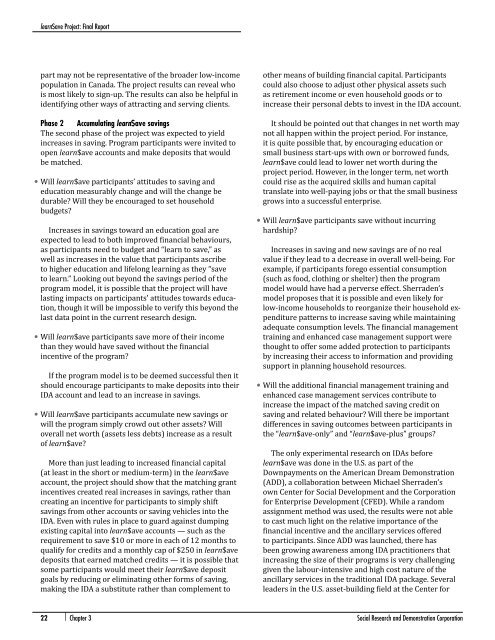Full report. - Social Research and Demonstration Corp
Full report. - Social Research and Demonstration Corp
Full report. - Social Research and Demonstration Corp
You also want an ePaper? Increase the reach of your titles
YUMPU automatically turns print PDFs into web optimized ePapers that Google loves.
learn$ave Project: Final Reportpart may not be representative of the broader low-incomepopulation in Canada. The project results can reveal whois most likely to sign-up. The results can also be helpful inidentifying other ways of attracting <strong>and</strong> serving clients.Phase 2 Accumulating learn$ave savingsThe second phase of the project was expected to yieldincreases in saving. Program participants were invited toopen learn$ave accounts <strong>and</strong> make deposits that wouldbe matched.• Will learn$ave participants’ attitudes to saving <strong>and</strong>education measurably change <strong>and</strong> will the change bedurable? Will they be encouraged to set householdbudgets?Increases in savings toward an education goal areexpected to lead to both improved financial behaviours,as participants need to budget <strong>and</strong> “learn to save,” aswell as increases in the value that participants ascribeto higher education <strong>and</strong> lifelong learning as they “saveto learn.” Looking out beyond the savings period of theprogram model, it is possible that the project will havelasting impacts on participants’ attitudes towards education,though it will be impossible to verify this beyond thelast data point in the current research design.• Will learn$ave participants save more of their incomethan they would have saved without the financialincentive of the program?If the program model is to be deemed successful then itshould encourage participants to make deposits into theirIDA account <strong>and</strong> lead to an increase in savings.• Will learn$ave participants accumulate new savings orwill the program simply crowd out other assets? Willoverall net worth (assets less debts) increase as a resultof learn$ave?More than just leading to increased financial capital(at least in the short or medium-term) in the learn$aveaccount, the project should show that the matching grantincentives created real increases in savings, rather thancreating an incentive for participants to simply shiftsavings from other accounts or saving vehicles into theIDA. Even with rules in place to guard against dumpingexisting capital into learn$ave accounts — such as therequirement to save $10 or more in each of 12 months toqualify for credits <strong>and</strong> a monthly cap of $250 in learn$avedeposits that earned matched credits — it is possible thatsome participants would meet their learn$ave depositgoals by reducing or eliminating other forms of saving,making the IDA a substitute rather than complement toother means of building financial capital. Participantscould also choose to adjust other physical assets suchas retirement income or even household goods or toincrease their personal debts to invest in the IDA account.It should be pointed out that changes in net worth maynot all happen within the project period. For instance,it is quite possible that, by encouraging education orsmall business start-ups with own or borrowed funds,learn$ave could lead to lower net worth during theproject period. However, in the longer term, net worthcould rise as the acquired skills <strong>and</strong> human capitaltranslate into well-paying jobs or that the small businessgrows into a successful enterprise.• Will learn$ave participants save without incurringhardship?Increases in saving <strong>and</strong> new savings are of no realvalue if they lead to a decrease in overall well-being. Forexample, if participants forego essential consumption(such as food, clothing or shelter) then the programmodel would have had a perverse effect. Sherraden’smodel proposes that it is possible <strong>and</strong> even likely forlow-income households to reorganize their household expenditurepatterns to increase saving while maintainingadequate consumption levels. The financial managementtraining <strong>and</strong> enhanced case management support werethought to offer some added protection to participantsby increasing their access to information <strong>and</strong> providingsupport in planning household resources.• Will the additional financial management training <strong>and</strong>enhanced case management services contribute toincrease the impact of the matched saving credit onsaving <strong>and</strong> related behaviour? Will there be importantdifferences in saving outcomes between participants inthe “learn$ave-only” <strong>and</strong> “learn$ave-plus” groups?The only experimental research on IDAs beforelearn$ave was done in the U.S. as part of theDownpayments on the American Dream <strong>Demonstration</strong>(ADD), a collaboration between Michael Sherraden’sown Center for <strong>Social</strong> Development <strong>and</strong> the <strong>Corp</strong>orationfor Enterprise Development (CFED). While a r<strong>and</strong>omassignment method was used, the results were not ableto cast much light on the relative importance of thefinancial incentive <strong>and</strong> the ancillary services offeredto participants. Since ADD was launched, there hasbeen growing awareness among IDA practitioners thatincreasing the size of their programs is very challenginggiven the labour-intensive <strong>and</strong> high cost nature of theancillary services in the traditional IDA package. Severalleaders in the U.S. asset-building field at the Center for22 | Chapter 3 <strong>Social</strong> <strong>Research</strong> <strong>and</strong> <strong>Demonstration</strong> <strong>Corp</strong>oration




